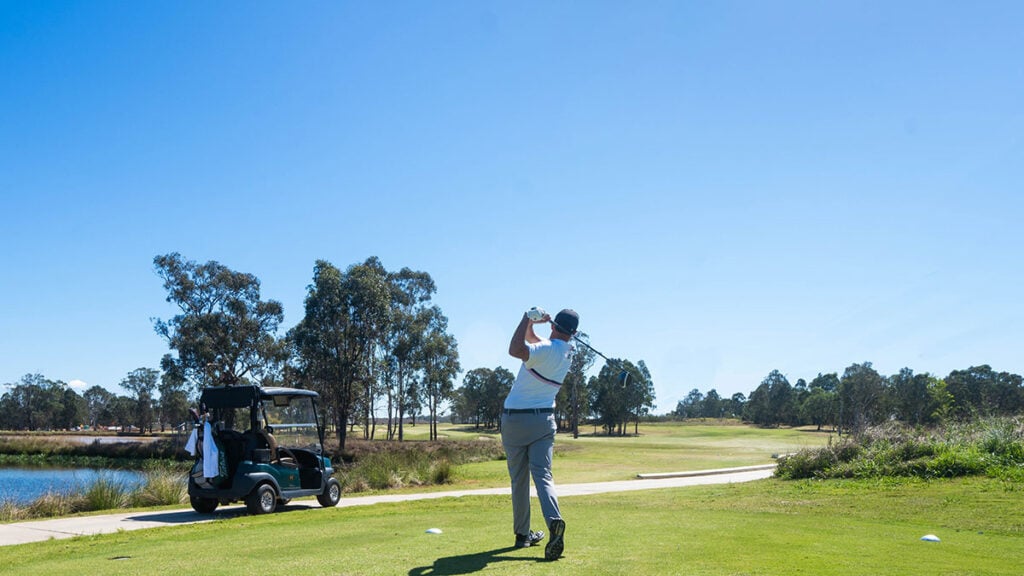The proposed limitations on green-reading materials, detailed by the ruling bodies in an announcement in July, will not be so limiting after all.
Following a six-week period of research and study of the detailed green-contour maps that many tour players and some elite college and amateur players have been using widely for the last few years, USGA and R&A officials announced overnight that there will be restrictions on the form of information players can use, but not exactly on the content. While the original proposal would have allowed only depictions of slope greater than 4 percent, the final rule will not include that restriction.
The final guidelines for green-reading materials, which go into effect January 1, will limit the scale for green diagrams to where a grid can be no more precise than 3/8-inch equalling 5 yards of the green. It also restricts the size of the book that contains any green information to the current pocket-sized form of most yardage books (approximately 4¼ inches by 7 inches).
But the new interpretation of Rule 4.3 (Use of equipment) essentially will not limit the depiction of slope by means of arrows or numbers or degrees as originally planned through its minimum slope indication. Nor will it restrict any handwritten notes about green contours in the books.
According to Thomas Pagel, USGA senior managing director of governance, the intent of the interpretation has not changed. “We are retaining the skill of reading a green,” he said. “Players will still have to use their eyes to read a green.”
Pagel said the review period, announced July 31, was productive and resulted in an interpretation that controls the role of technology going forward when it comes to reading the line of a putt.
“We had a number of really good conversations with tour players, caddies, developers, college coaches about how this information was used, and I would say it was one of the more challenging problems we faced,” Pagel told Golf Digest. “But I think what we’ve done here is put in place some effective guard rails around where we are now that prevents these materials from getting any more detailed in the future.”

The new interpretation, however, seems to shift from some of the original proposal’s fundamental convictions. In July, Pagel said, “Basically, the books are giving them a recommended line, and that goes too far. The skill of reading a green was diminishing, quickly going away. And we wanted to make sure it was retained.” But there were two factors that seemed to sway the decision away from specific restrictions on the information in any green-reading book. One was history, and the other was enforcement.
“First, we know the ability to take notes has been part of the game for a very long time, and we did not want to get away from that,” he said. “I also heard loud and clear about the challenge of enforcing the rule. Players were asking, How do I know if my notes are OK? and How do I know if the notes another player has on the other side of the fairway are OK?”
Pagel also noted that it isn’t just a PGA Tour issue. He said he heard from a number of college coaches whose players use green-reading books. One of their concerns was about the difficulty of enforcing a rule that specifically set a limit on contour notations in dozens of books used by dozens of teams at a tournament that might have only one rules official.
Pagel said the grid limitations still serve as an effective restraint against technology playing too great a role in diminishing the skill of reading a green.
“They can put as much detail as they like in the book, but there’s only so much information you can get in there, given the size of the grid,” he said. He said the limitation also applies to any digital forms of green-reading materials such that an app or other device must limit its information to the same 3/8-inch grid scale (1:480) without the ability to magnify sections of the green to include more information.
The green-reading restrictions also do not allow any digital form that would show players the line of a putt. It’s a technology seen in some smartphone apps such as GolfScope GPS, which uses augmented reality to depict the line of any putt from any position on the green. The rule’s guidelines also state that “no magnification of putting-green information is allowed other than a player’s normal wearing of prescription glasses or lenses.”
Pagel said the technology provided in green-reading materials actually has important benefits for the game, particularly in how it helps superintendents understand green contours and fair hole locations. He called the new rule “simpler and easier to understand.”
“We know where we are with this technology, and we understand where the intersection is between this technology and the way the game should be played,” he said. “We will be keeping our eyes on these things, and we need to be prepared to see where we are in the future.”




